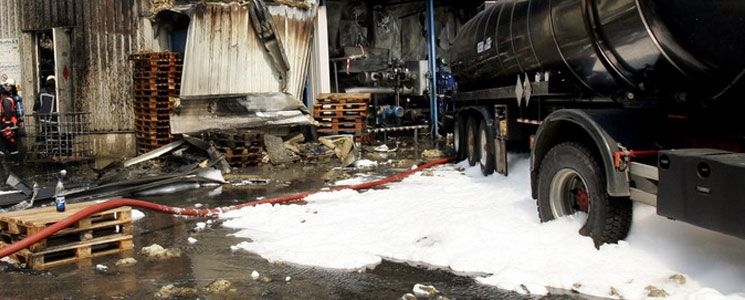 23/05/2017
23/05/2017
AD article about extinguishing foam
Following the article that was published today in the Algemeen Dagblad about toxic extinguishing foam we have received many questions from worried clients. This is very understandable. This is why we would like to respond to these questions.
Is it correct that the fire brigades use toxic extinguishing foam? Are there alternatives for fluorine-containing extinguishing foam with the toxic substance C8? And should firefighters be worried?
Why use fluorine-containing extinguishing foam?
Fluorine-containing extinguishing foam is used by fire brigades in the Netherlands for fighting liquid fires. The fluorine compounds in this extinguishing foam are essential for extinguishing a liquid fire. Without fluorine an essential quality in the extinguishing capacity is lacking: film formation. Film formation creates a film layer on the liquid fuel, so that it cannot ignite because it is shut off from oxygen.
Alternatives for fluorine-containing extinguishing foam
Unfortunately, fluorine compounds are harmful for humans and the environment. The C8 technology, which is described in the article of the Algemeen Dagblad, is directly related to the substance PFOS and to a lesser degree to the substance PFOA. The so-called C8-fluorine compounds which were used in extinguishing foam can/could be produced in two different ways. Manufacturer 3M was the inventor of one of these techniques, that is to say, the so-called electrochemical method. After a long-term study this technology proved to have high contents of the carcinogenic substance PFOS. Because of the risks of PFOS, the European Parliament decided to phase out PFOS-containing extinguishing foams. A same process took place in America. In 2002 3M finally felt compelled to withdraw as producer of extinguishing foams and the use of PFOS-containing extinguishing foam has therefore been banned in Europe since 2011.
At a later stage the so-called telomerisation process, with which C8-fluorine compounds are produced in an alternative way, was examined. Although the chance of PFOS and PFOA developing in and after this production process is considerably smaller, an investigation showed that this could not be excluded. The respective manufacturers and the American government therefore decided to tackle the problem jointly. The aim was to change the fluorine compounds in such a way that the unintended forming of PFOS and PFOA is excluded in theory. It is for this reason that Kenbri has not been selling this extinguishing foam with C8 technology anymore already since a few years. The brands which Kenbri represents, Angus and Fomtec, have switched completely to the C6 technology since a few years, in which molecule structures are shorter and no PFOS or PFOA can be formed in theory.
We do not have an overview of whether Dutch fire brigades are still using C8- extinguishing foam. Neither do we know which variant of the C8 technology it may concern. Kenbri would like to visit you in order to check this.
Another alternative for extinguishing foam containing fluorine is fluorine-free extinguishing foam. Fluorine-free extinguishing foam is alleged to be more> environmentally friendly. Although fluorine-free extinguishing foam works very well in certain cases, it is not more environmentally friendly by definition. An investigation has shown that this is the case in the long term, however fluorine-free extinguishing foam may be extremely harmful for the environment in the short term. Moreover, fluorine-free extinguishing foam extinguishes considerably less effectively in many cases. After all, the crucial film layer which causes the good extinguishing capacity of fluorine-containing extinguishing foam lacks fluorine-free variants. It is for this reason that much more of this foam is required with various fuels in order to extinguish well.
Risk for fire fighters
In the article of the AD toxicologist Jacob de Boer expresses his concerns about firefighters who use C8-extinguishing foam. He therefore advises firefighters to wear protective clothing to protect themselves against the harmful C8. We can definitely emphasise this statement, with the comment that we obviously always advised firefighters to wear protective clothing. Besides being subjected to soot and heat radiation, many fires also release toxic gases. Certainly when the fire scenario already stipulates that the extinguishing must take place with foam.
We therefore want to confirm the suggestion of De Boer that it is advisable to examine the blood of firefighters. Research suggests that PFOA is carcinogenic, as is the case with PFOS, but the threshold values are still being debated by science.
The bigger picture
Various studies confirm that C8-extinguishing foam containing fluorine may have harmful effects for humans and the environment. Not so much in the short term, but more in the medium term. Although the sellers of fluorine-free products have a strong lobby, we conclude that there still is no good alternative for extinguishing various liquid fires.
However, it is important to continue to look at the bigger picture. In 90% of the cases it is necessary to extinguish a liquid fire, both from an economic and enviromental perspective. With a large toxic fire, or for example a large fire in an oil tank with crude oil fire, brigades are currently forced to use extinguishing foam. When the fire is not extinguished, the environmental disaster is still many times greater and the consequences are incalculable. With this article we hope that we have given more clarity about the use of extinguishing foam and its risks. Do you still have any questions following this article
or the article in the AD? Then please contact us !



